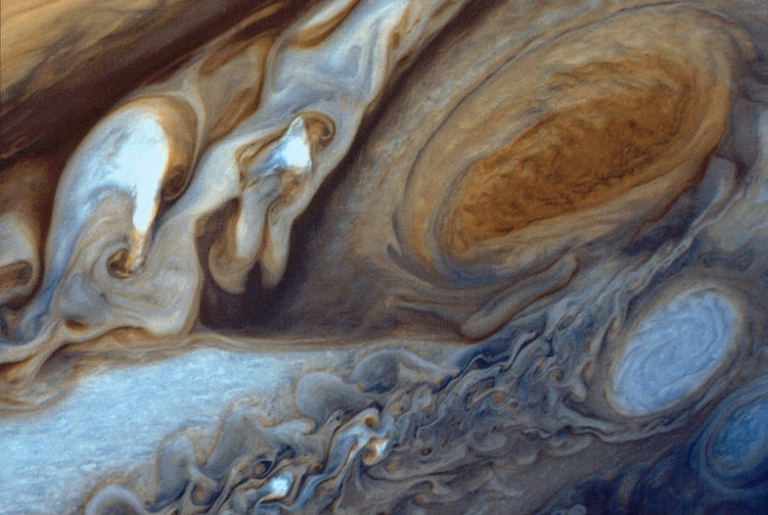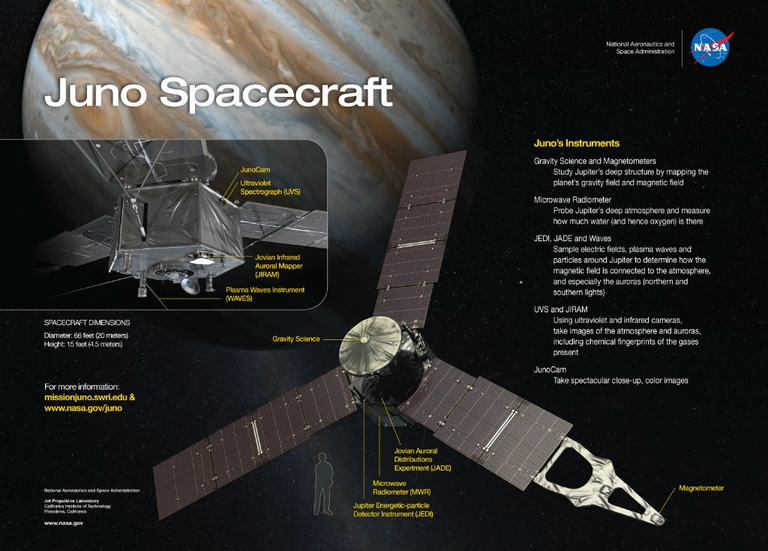
As per tradition after 12 years India held Mahakumbh, the world’s largest spiritual congregation that has been attracting pilgrims from across the globe.
Juno probe will turn around the gas giant for around 20 months, before disintegrating into the atmosphere.
It took 4 years, 11 months and almost three billion kilometres to get there. But on the 4th of July at 20.53 (local time in California), JUNO, acronym for Jupiter Near-polar Orbiter, entered into Jupiter’s orbit.
After turning on the motor for 35 minutes to reduce the speed to 542 metres per second (about 1950 kilometres per hour), Juno was captured by the gas-made giant’s gravity and pointed its 18,698 solar cells to the sun.
“Independence Day is always something to celebrate, but today we can add another reason to cheer on top of America’s birthday”, said Charlie Bolden, NASA’s CEO. “And what is more American than a NASA mission going boldly where no spacecraft has gone before?”
Besides being the pride of the space agency, the mission is fundamental for studying the biggest planet of the solar system. Its main aim is to investigate the origin and evolution of Jupiter. The spacecraft will investigate the hypothetical existence of a hard core, register the intensity of the planet’s magnetic field and measure the amount of water and ammonia in the planet’s deep atmosphere, under the clouds.
Teamwork❤️! From #Jupiter to Earth: thanks, team for guiding me into orbit. And now… SCIENCE https://t.co/4tR0S3XwyD pic.twitter.com/17Bia2UTkR
— NASA’s Juno Mission (@NASAJuno) 5 luglio 2016
A unique mission that will allow scientists to study and understand how gas giants form and which role they had in the formation of the solar system. This knowledge will help us study other solar systems too.
“The two Italian instruments on board of the JUNO satellite produced by ASI (the Italian Space Agency) are an example of scientific and technological excellence,” said Barbara Negri of ASI. “The JIRAM instrument (Jovian InfraRed Auroral Mapper) was designed to study the dynamics and chemistry of Jupiter’s aurorae in the near infrared”.
And that’s not all. KaT, the instrument measuring the distance and speed created by Thale Alenia Space, will also have a crucial role. “JUNO is a mission that will make history and in which NASA and ASI teamed up again in search of information to explain the origins of the solar system”, the President of ASI Roberto Battiston stated. “The study of Jupiter is also a major scientific and technological challenge in which Italy takes part with two advanced tools, thanks to INAF and industries including Leonardo Finmeccanica and Thales Alenia Space”.
Now we must wait for the first data to come to Earth.
Siamo anche su WhatsApp. Segui il canale ufficiale LifeGate per restare aggiornata, aggiornato sulle ultime notizie e sulle nostre attività.
![]()
Quest'opera è distribuita con Licenza Creative Commons Attribuzione - Non commerciale - Non opere derivate 4.0 Internazionale.
As per tradition after 12 years India held Mahakumbh, the world’s largest spiritual congregation that has been attracting pilgrims from across the globe.
Though eating is a primary necessity for astronauts, it doesn’t mean it’s necessarily a pleasure. The first meals eaten in space were flavourless, odourless and lacked consistency. But times have changed, and a healthy, balanced, and tasty diet is essential for astronauts to go through long periods at the International Space Station, without negative impacts
L’astronauta Scott Kelly ha pubblicato la foto della prima zinnia sbocciata nello spazio. Segno che anche i fiori possono crescere in condizioni di microgravità.
Workers in tea gardens of West Bengal, India, that produces Ctc tea for domestic consumption complain that they have been devoid of basic facilities while political parties make hollow promises during every elections which are never fulfilled.
India is in the middle of the elections, but sadly none of the politicians have uttered a word on man-animal conflict that has been devouring several lives every year.
Manipur, a state in north-east India, is still reeling under the tremors of violence that broke out last year devouring lives and paralyzing the economy.
The government of Tanzania is currently planning to evict more than 80.000 indigenous Maasai people from their ancenstral land
A new UNU-INWEH report on the global bottled water industry reveals the massive scale of this market and the lack of strict quality controls.
Isatou Ceesay founded a social enterprise that is helping to fight plastic pollution and empowering women and young people to gain economic independence.









